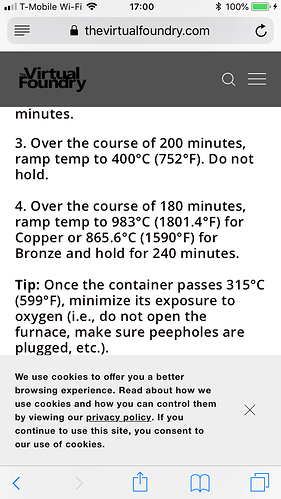Do we fire our kiln to cone 10? I was reading about a new 3d metal filament that can print in any fdm printer, but requires finishing off in a kiln cone 10, and I dont know enough about our kiln or kilns in general.
I think we fire at cone 6
We glaze fire to Cone 5. We did run a Cone 10 firing last fall, but it’s not normal for us since we have everyone working with cone 5 clays and glazes. If there were enough folks with interest we could consider doing so again if we thought we could fill the kiln. Firing high like that wears the elements out faster.
For a one-time burn of something that needs to get hot, there’s the small oven that belongs to the jewelry lab. It’ll go to 2000° F. Your piece would need to be less than 5" x 5" x 5" or so. If interested, ask Dean about it. I’m not sure he has any assistants in there yet.
I saw that, and the gears started turning. And now, I could 3D print those gears out of METAL!!!
Looks like that may not be quite hot enough: Pyrometric Cone Temperature Conversion Chart - Clay-King.com
That chart shows cone 10 at over 2300.
Wow. That’s pretty hot. I wonder what metals are in that stuff?
The cone 10 is to completely eliminate the pla.
Are you sure it’s not ‘010’ 10 will melt most metals.
It can be confusing that there is a cone 04 and cone 4 or 010 and 10.
From what I can gather from your link John it’s more in the 07 to 013 range.
For anyone interested cone temperatures vary in degree based on the time the temperature is achieved. The cone is based on heat work.
A simple explanation from Orton the maker of test cones.
‘Heatwork is a term used to describe the combined effect of time and temperature on the ware you are firing. Firing ceramics is very similar to cooking a cake. In many recipes, we must choose a temperature setting and also a time. For example, a cake recipe will say cook at 375 for 45 minutes for a sheet cake. However, if you were making cupcakes, the time is reduced to 30 minutes. It will take less time to cook the cupcakes since the heat is absorbed faster into smaller items. In ceramics, you must also allow the ware to absorb heat for a period of time. You cannot fire porcelain by placing it into a kiln set to reach 2232 F in one hour. It would be grossly underfired. An additional 19 hours would be required to mature the porcelain.’
I was told cone 10, but after reading that link I posted, I’ll assume its for using material like stainless steel, which needs 1200 Celcius. I’ll bet copper, bronze and brass could use a much lower temperature.
